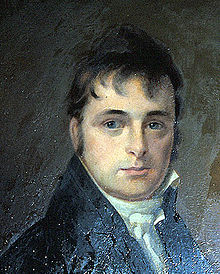Frederick Bates (politician): Difference between revisions
m →External links: tags and general fixes, removed stub tag using AWB (8853) |
add ref. section & ref., tag refimprove |
||
| Line 1: | Line 1: | ||
{{refimprove}} |
|||
{{Infobox Politician |
{{Infobox Politician |
||
| name = Frederick Bates |
| name = Frederick Bates |
||
| Line 20: | Line 22: | ||
| signature = |
| signature = |
||
}} |
}} |
||
'''Frederick Bates''' (June 23, |
'''Frederick Bates''' (June 23, 1777–August 4, 1825), older brother of [[Edward Bates]] and [[James Woodson Bates]], was an [[United States|American]] [[Lawyer|attorney]] and [[politician]]. He was [[Missouri gubernatorial election, 1824|elected in 1824]] as the second governor of [[Missouri]] and died in office in 1825. Before that he had served as a Justice of the Territorial Supreme Court for [[Michigan Territory]], was appointed by [[Thomas Jefferson]] as Secretary of the Louisiana Territory and started to build his political base in [[St. Louis]]. |
||
==Early life and education== |
==Early life and education== |
||
Born in 1777 into the [[Plantations in the American South|planter]] class in [[Goochland County, Virginia]], Bates was schooled privately at his family's Belmont plantation by tutors. Later he went to college and read the law with an established firm. |
Born in 1777 into the [[Plantations in the American South|planter]] class in [[Goochland County, Virginia]], Bates was schooled privately at his family's Belmont plantation by tutors. Later he went to college and read the law with an established firm. He settled in Detroit in 1797 and became its first postmaster in 1803.<ref>Dunbar, Willis F. & May, George S. (3d ed. 1995). [http://books.google.com/books?id=HqGWEAnByeMC&pg=PA113 ''Michigan: A History of the Wolverine State''], p. 113. Wm. B. Eerdmans Publishing Co.</ref> |
||
==Career== |
==Career== |
||
| Line 39: | Line 41: | ||
==Legacy and honors== |
==Legacy and honors== |
||
*[[Bates County, Missouri]] is named after Frederick Bates. |
*[[Bates County, Missouri]] is named after Frederick Bates. |
||
==References== |
|||
{{Reflist}} |
|||
==External links== |
==External links== |
||
Revision as of 19:01, 17 February 2013
This article needs additional citations for verification. |
Frederick Bates | |
|---|---|
 | |
| 2nd Governor of Missouri | |
| In office November 15, 1824 – August 4, 1825 | |
| Preceded by | Alexander McNair |
| Succeeded by | Abraham J. Williams |
| Personal details | |
| Born | June 23, 1777 Belmont, Virginia |
| Died | August 4, 1825 (aged 48) Chesterfield, Missouri |
| Spouse | Nancy Opie Ball |
| Relations | brothers Edward Bates and James Woodson Bates |
| Children | Emily Caroline (1820–1891), Lucius Lee (1821–1898), Woodville (1823–1840) and Frederick Jr. (1826–1862) |
Frederick Bates (June 23, 1777–August 4, 1825), older brother of Edward Bates and James Woodson Bates, was an American attorney and politician. He was elected in 1824 as the second governor of Missouri and died in office in 1825. Before that he had served as a Justice of the Territorial Supreme Court for Michigan Territory, was appointed by Thomas Jefferson as Secretary of the Louisiana Territory and started to build his political base in St. Louis.
Early life and education
Born in 1777 into the planter class in Goochland County, Virginia, Bates was schooled privately at his family's Belmont plantation by tutors. Later he went to college and read the law with an established firm. He settled in Detroit in 1797 and became its first postmaster in 1803.[1]
Career
After working as an attorney, Bates started his political career when appointed as a Justice of the Territorial Supreme Court for Michigan Territory in Detroit, Michigan. He received a significant promotion when the Aaron Burr conspiracy was uncovered. In February 1807, while Bates was in Washington, President Thomas Jefferson appointed him to be Secretary of the Louisiana Territory, as well as a recorder of land titles. He held this position in St. Louis until 1812. Bates helped determine whether conflicting French, Spanish, and American land claims in the territory would be upheld, as it had been subject to three differing political systems.
Jefferson had already decided on the returning explorer and fellow Virginian Meriwether Lewis as governor of the huge new Louisiana Territory, which approximately equaled the size of the existing United States. Bates preceded Lewis to St. Louis and became a powerful political force in the new territory; he was a political rival of Lewis until the latter's death while traveling from St. Louis to Washington on business in 1809. Later, as Secretary of the newly formed Missouri Territory (1812–1821), he became acting governor in the frequent absences of Territorial Governor William Clark.
In the August 1824 election, Bates was elected the second governor of Missouri. He died in office in August 1825 in Chesterfield, Missouri, due to a short illness thought to be pneumonia. Bates was buried at the family cemetery on the Thornhill estate near St. Louis.
Marriage and family
In 1819, Bates married Nancy Opie Ball (1802–1877), daughter of a wealthy Virginia colonel. The couple had four children, Emily Caroline (1820–1891), Lucius Lee (1821–1898), Woodville (1823–1840) and Frederick Jr. (1826–1862).
During his time in Missouri, Bates acquired nearly 1000 acres (4 km²) of land, which he called Thornhill. He had built a Federal-style home with high ceilings for summer ventilation, fine woodwork and a sophisticated floor plan; all this would have been familiar to Bates from his childhood home, Belmont, in Goochland County, Virginia. The Thornhill estate still exists today and can be viewed by the public. It is located in Faust County Park in Chesterfield, Missouri.
Legacy and honors
- Bates County, Missouri is named after Frederick Bates.
References
- ^ Dunbar, Willis F. & May, George S. (3d ed. 1995). Michigan: A History of the Wolverine State, p. 113. Wm. B. Eerdmans Publishing Co.

